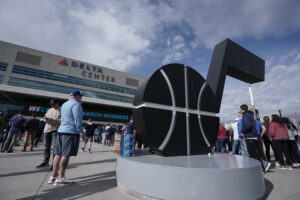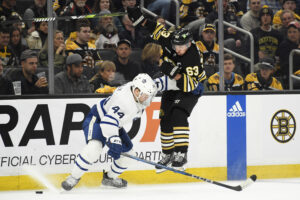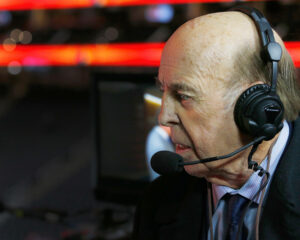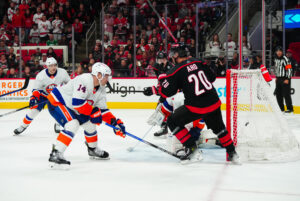NHL trades used to be a regular occurrence. It was not unusual to have six to eight trades happen during the course of the regular season (and not just at the deadline). But those days and trades are long gone. Now there is only a smattering of trades around the draft and deals at the trade deadline, mostly for players who become unrestricted free agents at season’s end. Other than, there aren’t many NHL trades anymore. But why?
Why Aren’t There Many NHL Trades Anymore?
The biggest reason the NHL hardly has any trades anymore is clearly because of the hard salary cap. This severely limits teams going after big acquisitions in trades.
In terms of salary-cap flexibility, 21 of the 30 NHL teams have $1.5 million or less in cap space. Only three teams have more than $5 million in cap space. They are the Florida Panthers, the New Jersey Devils, and the Carolina Hurricanes. Should be noted that next season the Panthers will be a cap-ceiling team as Aaron Ekblad‘s cap number will go from 925K to $7.5 million.
Even if teams can agree on a trade in terms of talent, that is just one major hurdle that has been passed. The salary cap creates another major hurdle to complete trades and then some.
Rising Player Salaries & Cap Ceiling
While the NHL has certainty in terms of total player payroll, this has not stopped player salaries from skyrocketing. When analyzing player salaries over the least five years it’s astounding in terms of the increase.
For the 2011-12 season, 23% of the players had a cap hit of $4 million annually. For the 2016-17 season, that percentage has risen to 39.5%. In addition, the number of players making between $4-6 million has nearly doubled (increase of 79%). Players making at least $7 million annually has nearly doubled as well (17 players to 33).
Compound the player salaries incredible rise with a crawling salary cap ceiling, and it has left NHL general managers with very little cap flexibility. Currently, the NHL cap ceiling sits at $73 million. The last couple of years the cap ceiling has only increased a couple of million each season.
At the end of the day, NHL salaries are accelerating at a phenomenal pace, while the cap ceiling only increases marginally on a yearly basis. All of this adds up to no cap space for most teams.
Cap space available for each NHL team per https://t.co/BUXKbSKVTL pic.twitter.com/kt8uy4zOb8
— Hoop Informatics 🏀📊🎥 (@HoopInformatics) October 17, 2016
Entry-Level Contracts
Players on entry-level deals are vital because they count so little against the cap and yet can make many positive contributions to a hockey club. A player’s entry-level deal lasts three years and is below a $1-million cap hit annually. Having that kind of player is essential, and therefore makes them very valuable to an organization. Trading players on entry-level contracts is very difficult to do from a cap perspective.
Basically, ELC players give hockey teams a huge bang for their salary cap buck.
General managers have to manage their salary cap both in the short and long term and this is a huge task. Every productive low-cost player is gold to a GM, especially with the rise of player salaries.
Value of Draft Picks
NHL-drafted players are getting to the league faster than ever. There was a time when even a first or a second-round pick player needed four to five years of development to make it to the NHL. Now more than ever due to how big and strong today’s drafted players are, a majority of them are making it to the league in two to three years time, in some cases even sooner.
This has made draft picks more valuable than ever. If a general manager could make a significant deal now giving next year’s first-round pick, who is four or five years away, he wouldn’t hesitate. But if the timeline is more like two or two-and-a-half years away, that makes trading a top draft pick much harder to do in today’s NHL salary cap world.
Current Trade Landscape
The current trade landscape has made the waters very risky and uncertain in terms of making a deal. Most general managers are aware of this. A trade that goes south could have a number of negative implications for a hockey club.
Also because there are so few meaningful trades anymore each one gets put under a microscope. That’s a place NHL GM’s don’t want to be.
The trend of lack of meaningful trades will not be changing anytime soon, as these factors will just become more prevalent each year.
Main Photo.






